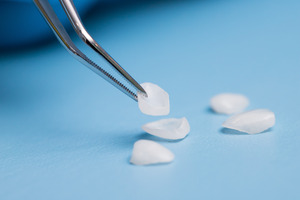
Veneers can help make the smile of your dreams a reality, but it’s important to remember that the procedure is considered irreversible. That’s because to place veneers, a small amount of enamel needs to be removed from the teeth in question. Exactly how much enamel can you expect to be taken off? And why is it necessary to have it removed in the first place? Your dentist has the answers.
Why Enamel Needs to Be Removed for Veneers
The goal of veneers is to aesthetically enhance your teeth by covering up chips, stains, and other flaws. As such, they are designed to look as natural as possible. However, if a veneer is immediately placed on a tooth that hasn’t been prepared first, it might result in a bulky appearance. Removing a small amount of enamel will help ensure that the veneer blends in with the rest of your grin.
Furthermore, veneers tend to have a harder time staying attached to unprepared teeth. By removing enamel, your dentist can create a surface that’s easier for your veneer to adhere to, thus making it less likely to fall off.
How Much Enamel Needs to Be Removed for Veneers?
The answer can vary depending on your unique circumstances, but most of the time the dentist will only need to take off about half a millimeter of enamel. The goal is to preserve as much of the tooth’s natural structure as possible while still creating enough room for the veneer. Keep in mind that enamel does not grow back once it has been removed; as such, the prepared tooth will always need to be covered with a veneer or another type of restoration.
What is the Process for Getting Veneers?
The veneer process usually takes two appointments. The first visit is when enamel will be removed from the tooth or teeth in question. Afterward, your dentist will take impressions of your mouth so that a dental lab can design veneers that match the size, shape, and color of your other teeth. Temporary veneers will be placed on your teeth to protect them while the permanent ones are made.
Your dentist will schedule your second appointment once they’ve received your veneers. Some minor adjustments might need to be made during this visit to ensure that your veneers fit properly. The final step is to attach your veneers to your teeth with a special adhesive.
If you’re looking to transform your smile by making multiple cosmetic corrections at once, veneers can be a commitment worth making. Reach out to your dentist today to see if veneers are the right choice for your grin.
About the Author
Dr. George Keanna earned his dental degree from the Georgetown University School of Dentistry. Today at Natural Dental Services in Albuquerque, he provides holistic dental services that address oral health problems in a way that benefits the entire body. For patients who want to enhance the appearance of their smiles, he offers veneers as well as other cosmetic treatments. To schedule an appointment with Dr. Keanna, visit his website or call (505) 292-8533.
